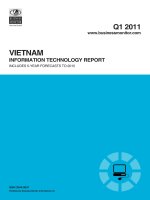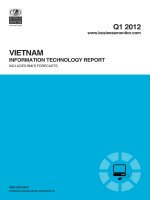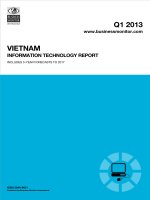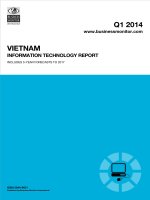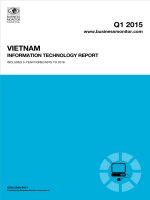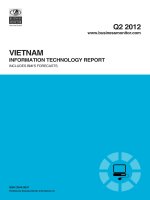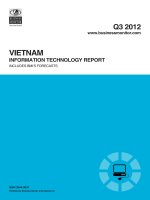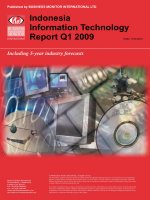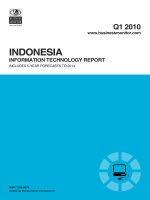United states information technology report q1 2012
Bạn đang xem bản rút gọn của tài liệu. Xem và tải ngay bản đầy đủ của tài liệu tại đây (564.26 KB, 69 trang )
Q1 2012
Published by Business Monitor International Ltd.
www.businessmonitor.com
INFORMATION TECHNOLOGY REPORT
ISSN 2041-7101
Published by Business Monitor International Ltd.
UNITED STATES
INCLUDES BMI'S FORECASTS
Business Monitor International
85 Queen Victoria Street
London
EC4V 4AB
UK
Tel: +44 (0) 20 7248 0468
Fax: +44 (0) 20 7248 0467
email:
web:
© 2012 Business Monitor International.
All rights reserved.
All information contained in this publication is
copyrighted in the name of Business Monitor
International, and as such no part of this publication
may be reproduced, repackaged, redistributed, resold in
whole or in any part, or used in any form or by any
means graphic, electronic or mechanical, including
photocopying, recording, taping, or by information
storage or retrieval, or by any other means, without the
express written consent of the publisher.
DISCLAIMER
All information contained in this publication has been researched and compiled from sources believed to be accurate and reliable at the time of
publishing. However, in view of the natural scope for human and/or mechanical error, either at source or during production, Business Monitor
International accepts no liability whatsoever for any loss or damage resulting from errors, inaccuracies or omissions affecting any part of the
publication. All information is provided without warranty, and Business Monitor International makes no representation of warranty of any kind as
to the accuracy or completeness of any information hereto contained.
UNITED STATES
INFORMATION
TECHNOLOGY
REPORT Q1 2012
INCLUDES 5-YEAR FORECASTS TO 2016
Part of BMI's Industry Report & Forecasts Series
Published by: Business Monitor International
Copy deadline: January 2012
United States Information Technology Report Q1 2012
© Business Monitor International Ltd Page 2
United States Information Technology Report Q1 2012
© Business Monitor International Ltd Page 3
CONTENTS
Executive Summary 5
SWOT Analysis 8
United States IT Sector SWOT 8
United States Political SWOT 8
United States Economic SWOT 9
United States Business Environment SWOT 9
IT Business Environment Ratings 10
Table: Regional IT Business Environment Ratings 13
Markets Overview 14
Americas 14
Market Overview – United States 22
Government Authorities 22
Hardware 25
Drivers 26
Tablet Notebooks 28
Software 29
Services 32
Industry Developments 34
Industry Forecast Scenario 37
Market Trends 37
Drivers 38
Table: United States' IT Sector – Historical Data & Forecasts (US$mn Unless Otherwise Stated) 39
Internet 40
Table: Telecoms Sector – Internet – Historical Data & Forecasts 40
Macroeconomic Forecast 42
Table: United States – GDP Contribution To Growth 45
Competitive Landscape 46
Hardware 46
Software 49
Company Profiles 55
HP 55
Dell 57
Microsoft 59
IBM 61
Country Snapshot: US Demographic Data 62
Section 1: Population 62
Table: Demographic Indicators, 2005-2030 62
Table: Rural/Urban Breakdown, 2005-2030 63
Section 2: Education And Healthcare 63
Table: Education, 2002-2005 63
Table: Vital Statistics, 2005-2030 63
Section 3: Labour Market And Spending Power 64
Table: Employment Indicators, 2001-2006 64
United States Information Technology Report Q1 2012
© Business Monitor International Ltd Page 4
Table: Consumer Expenditure, 2000-2012 (US$) 64
Table: Average Annual Wages, 2000-2012 (US$) 65
BMI Methodology 66
How We Generate Our Industry Forecasts 66
Transport Industry 66
Sources 67
United States Information Technology Report Q1 2012
© Business Monitor International Ltd Page 5
Executive Summary
Market Overview
US spending on IT products and services is forecast to reach US$669bn by 2016.
US spending on IT products and services is forecast to reach US$551bn in 2012. BMI has downwardly
revised its forecast after PC sales were flat in Q311, after a sharp annualised contraction in H111. In
2012, IT vendors will be considered when it comes to the effect of the ongoing US federal deficit issue,
and the failure of politicians to agree on a deficit reduction programme. If automatic federal spending cuts
kick in during the next fiscal year, this could hit IT projects.
A major demand driver will be private and public sector organisations looking for help to utilise
efficiencies from cloud computing models such as Software-as-a-Service and Infrastructure-as-a-Service.
2010 saw a number of government agencies at federal and local level launch cloud strategies and pilot
programmes.
Other key market drivers are expected to include:
Growing fixed and mobile broadband penetration.
Data centre consolidation and virtualisation
Product innovation such as tablets, e-readers and feature-rich netbooks.
Technology innovation such as GPS and services.
Economic recovery.
Industry Developments
GSA first federal agency to move all email to a cloud-based system
The first 2013 federal budget proposals are expected in February 2012 and may provide an indication
about how cuts may impact federal IT spending. The government has to cut US$1.2trn over ten years
from federal spending according to a process called "Sequestration." In 2011, more than 50 tech
companies wrote a letter to the Super Committee urging it to reach a solution and avoid "the sequestration
trigger."
Despite a drive to cut expenses across government, in 2011 many public sector organisations appeared
willing to continue to spend on IT. The Obama administration has called on federal agencies to develop
strategies to simplify and where possible combine often sprawling IT operations so as to reduce costs.
United States Information Technology Report Q1 2012
© Business Monitor International Ltd Page 6
Guidelines published in 2010 by the Office of Management and Budget called for agencies to initiate data
centre consolidation programmes to help cut US$3bn from the federal budget.
Competitive Landscape
The US PC competitive landscape is dominated by two large domestic vendors, Dell and HP,
which together account for at least 50% of the US market.
In H111 several vendors suffered from the sharp slowdown in the US market, which was caused
by lacklustre consumer demand. Acer, whose traditional strength is in the consumer segment, was hit the
hardest by the market contraction. HP was another major loser, with negative sales growth in the region
of 10%, but the company's market share grew in Q311. Meanwhile Apple's PC market share of around
11% was driven by the success of its iPad, as tablets took away share of traditional PC sales.
Computer Sales
The US addressable market for PCs and accessories is estimated by BMI at US$145.8bn in
2012, with single-digit growth compared with 2011.
BMI forecasts that the US computer and accessories market value will grow around 2.5% in 2012, with similar
single-digit growth compared with 2011. We downwardly revised our figures after PC sales remained contracted in
H111 y-o-y, and remained flat in Q311. The computer hardware market's 2012-2016 CAGR is projected at 3.1%
and market value could reach US$165bn by 2016.
One additional driver of increased sales and lower prices is the move of telecoms operators into the PC
retail space. Notebooks are the fastest-growing PC market segment but face competition from other
formats such as tablets, which appear to have growing traction in the enterprise segment.
Software
The US software market is estimated at US$159.9bn in 2012, with single-digit growth from
2011.
Software CAGR for 2012-2016 is projected at around 5.9%, as the addressable market reaches around
US$201.1bn. A combination of enterprise objectives such as cost reduction and greater efficiency should
combine to encourage the adoption of cloud services in 2011.
Drivers of demand for enterprise software include increasing operational efficiency, coordinating global
supply chains and modernising logistics and warehouse functions. More investment can be expected to be
in utility software and serviced-oriented architectures rather than traditionally packaged PC software.
United States Information Technology Report Q1 2012
© Business Monitor International Ltd Page 7
IT Services
The US IT services market is forecast at US$245bn in 2012, with demand restrained by fiscal
austerity and political and economic uncertainty.
IT services spending is expected to grow about 2% in 2012, building on a stabilisation of the market in
the previous year. Spending on IT services is quite closely correlated with GDP growth, which is bad
news in a recession but better news in a recovery.
One opportunity will be organisations looking for help to utilise efficiencies from cloud computing such
as SaaS and IaaS, as organisations look to save money on IT investments. National and local government
is one vertical where strong interest in cloud services is being expressed.
In H111 Microsoft's dominance with its Windows software appeared to be under threat of erosion from
the surge in demand for non-Windows tablets. Analysts have long worried about Microsoft's potential
over-reliance on Windows to drive its revenue, and the vendor's Q111 sales of Windows fell short of
expectations. However, Microsoft's overall revenue actually rose 13% in Q311, thanks mainly to strong
sales of Microsoft Office
United States Information Technology Report Q1 2012
© Business Monitor International Ltd Page 8
SWOT Analysis
United States IT Sector SWOT
Strengths
The largest IT market in the world, with spending forecast to pass US$529bn in 2011.
Despite the challenging trading conditions, overall IT spending is still expected to
remain in positive growth territory.
Weaknesses
During the recession in 2009, customers postponed projects and reduced short-term
spending, particularly in areas such as consulting and software development.
Opportunities
Demand for new IT strategies to take advantage of innovations such as virtualisation,
data centre consolidation, and cloud computing
As economic woes ease, IT vendors should see more growth from traditional big-
spending sectors such as banks, financial services, retail and manufacturing.
The growing popularity of mobile broadband networks is driving netbook sales.
New business models such as SaaS and virtualisation will continue to make progress.
Threats
There is a risk that recovery could be anaemic in 2011, in which case spending on
technology could have another hard year.
A large federal budget deficit could lead to pressures on public sector IT spending.
United States Political SWOT
Strengths
The US is an undisputed superpower, and therefore occupies centre stage in most
international diplomacy. Long-standing democracy with vigorous and open political
debate; the US continues to attract large numbers of immigrants committed to
citizenship and self-advancement.
Weaknesses
Political debate between Republicans and Democrats has historically been polarised
and divisive. As today's superpower, the US attracts the enmity of a wide range of
political groups opposed to the current international status quo.
Opportunities
The changing political mood (as evidenced by the popularity of unconventional
candidates in the 2008 presidential election, including President Barack Obama's),
and the widespread dissatisfaction of the voting public, may encourage both major
parties to experiment with more consensual approaches to certain policy areas.
Though we are not optimistic, the ongoing budget debates will provide a pertinent test
of the degree to which bipartisan cooperation is possible.
Threats
The perception of inflexibility and bias in US foreign policy, particularly in the Middle
East, may stiffen opposition and at worst provide fertile recruiting ground for radical
anti-US groups such as al-Qaeda. Partly as a reaction to foreign policy difficulties, US
public opinion may return to isolationist and protectionist modes.
United States Information Technology Report Q1 2012
© Business Monitor International Ltd Page 9
United States Economic SWOT
Strengths
The world's largest economy with an impressive record of entrepreneurial dynamism,
innovation and a high research and development spend. Despite some threats to its
reserve status, the US dollar is treated as an international currency, meaning that
investors around the world are prepared to hold US debt. Because of this, the US is
uniquely able to run large fiscal and current account deficits.
Weaknesses
Despite the dollar's role as an international currency, excessive US debt levels are a
risk. A decision by Japanese and Chinese central banks to reduce their larger dollar
holdings could cause sharp falls in the value of the US currency. Low savings rate by
US households on a historic basis, although this has begun to reverse.
Opportunities
Further liberalisation of international trade through the WTO, coupled with a more
competitive dollar exchange rate, could boost export growth and help restore balance
to the US's external imbalances.
Threats
Intensified competition from China and other low-wage economies could accelerate
the loss of manufacturing jobs. Large growth in public spending, coupled with tax cuts,
will worsen the fiscal deficit, eventually forcing more restrictive monetary policy and
slower growth.
United States Business Environment SWOT
Strengths
The US boasts the world's largest single internal consumer market, which presents
tremendous opportunities for businesses of all types and sizes.
Few countries offer better environments for entrepreneurial activity, with a highly
flexible labour force, a legal system that is friendly to business, and significant centres
of technological innovation (such as California's Silicon Valley).
Weaknesses
Much of the country's physical infrastructure is in need of improvement, with
congested roads and airways.
US corporate tax is, on average, among the highest in the OECD.
Opportunities
The Obama administration is committed to improving the nation's infrastructure, with
stimulus package funds being dedicated to that purpose.
The US has often been the origin of new drivers of economic growth booms, and
sectors ranging from biotechnology to alternative energy are being discussed as
possible catalysts.
Threats
Government intervention in the economy puts the country's reputation for free
enterprise at risk.
United States Information Technology Report Q1 2012
© Business Monitor International Ltd Page 10
IT Business Environment Ratings
BMI's Americas IT Business Environment Ratings compare the potential of a selection of the region's
markets over our forecast period to 2016. The ratings reflect our consideration of political and economic
risks, as well as risks associated specifically with IT intellectual property rights protection and the
implementation of government information and communications technology (ICT) projects.
The US retains its top position in our regional rankings as by far the largest IT market in the region and
the world, accounting for about 25% of global IT spending. Despite a weak economic recovery and the
challenge from faster-growing IT markets such as Brazil, the US is forecast to maintain its global IT
market leadership position.
However, IT vendors will consider the impact of the failure of politicians to agree a US federal deficit
reduction programme. If automatic federal spending cuts kick in during the next fiscal year, this could
have an effect on IT projects. Meanwhile, in the first three quarters of 2011, US PC sales dipped sharply
as a result of the economic uncertainty, which is expected to persist in 2012, an election year. These
actors have seen the US lose ground in our Q112 ratings, compared with Latin American markets.
During the next few years, across consumer and business segments, US IT spending is expected to be
driven by a number of factors including product and technology innovation, and investment in fixed and
mobile broadband infrastructure as well as economic recovery. A major opportunity will be demand from
private and public sector organisations aiming to use cloud computing services. In 2012 there are
expected to be many more contracts awarded by federal and state and municipal governments for the
provision of cloud services. However, the rate of growth in traditional big-spending IT verticals such as
financial services, retail and manufacturing will depend on confidence in a sustainable economic
recovery.
In Q112, Canada maintains its second place in our rankings table, but sees its rating reduced relative to
other Americas markets such as Brazil. Despite current fiscal constraints, the Canadian government's
digital economic strategy provides a framework for IT market growth. Cost reviews have been conducted
by Toronto and Ontario, but some recent large tenders point to continued opportunities. One key initiative
is Broadband Canada, which has a mandate to expand broadband coverage to underserved areas.
Despite Canada being a relatively mature market, there still remains plenty of potential for software
vendors in industries such as consumer products, telecommunications, energy, engineering, construction,
transport and food and beverage as well as retail. Growing interest in cloud computing is expected, with
Canada currently lagging the US and some other advanced markets.
The Latin American IT market outlook remains positive with most markets receiving a ratings upgrade in
Q112. Low PC penetration means continued growth potential in a region characterised by significant
United States Information Technology Report Q1 2012
© Business Monitor International Ltd Page 11
income and geographic disparities. In many markets, increased penetration of credit cards and credit
availability from stores, as well as a growing organised retail sector, should contribute to growth. There is
also a boost from government ICT initiatives and growing regional interest in cloud computing. The
region has seen strong growth in uptake of services such as software-as-a-service (SaaS), which should
continue.
Brazil is expected to be one of the best performing regional IT markets over BMI's five-year forecast
period, with double-digit growth. The government's US$344mn modernisation strategy, launched in late
2010, should mean enhanced IT spending over the next few years. The National Broadband Plan was also
announced in 2010, and modernisation, ahead of Brazil's hosting of the 2014 FIFA World Cup and 2016
Summer Olympics, should help to drive demand for IT products and services.
In 2012, Brazilian consumer PC sales are expected to continue to grow, due to economic growth and low
unemployment fuelling consumer confidence. In 2011, consumer PC sales were up by more than 20%,
thanks to economic growth, revived business confidence and low unemployment, which fuelled consumer
confidence. Meanwhile, a PC penetration rate of less than 25% indicates there is plenty of room for
market growth.
Brazil is our third highest ranked market in North and South America, ahead of Mexico, which drops
back one place into fourth position. Brazil scores higher than Mexico on market and country structure
factors, but both have strong growth drivers. Mexican IT spending is expected to grow at a double-digit
compound annual growth rate (CAGR) over BMI's five-year forecast period.
Brazil and Mexico account for about 75% of PC sales in Latin America, with economic growth lifting
millions into a computer-owning middle class. However, Brazil ranks higher than Mexico due to market
size and country structure environment. At twice the size of Mexico's market, Brazil is already estimated
to be the fifth largest PC market in the world. However, Brazil's company spending on IT, measured as a
percentage of revenues, is understood to lag behind global peers. Growing broadband penetration,
including 3G mobile, will drive the PC markets of both countries.
Public sector projects will be an opportunity for vendors due to a substantial information society budget
and the rollout of national and local projects that were previously delayed. Public sector organisations are
launching e-services and supporting infrastructure. Other market drivers include rising PC penetration and
growing PC affordability, as well as US corporate demand for IT outsourcing. Business IT investment is
also expected to trend upwards particularly in the large and medium company sectors.
Close ties with the US are a long-term driver of Mexican IT opportunities. For example, the city of
Monterrey is becoming an important outsourcing hub. However, despite business environment
improvements, there are structural inhibitors in Mexico and Brazil. In Brazil these include a significant
digital divide and bureaucracy. Mexico has a heavily regulated labour market, and some vendors also
have concerns about an apparent escalation in drug violence, which may affect channel activities in some
United States Information Technology Report Q1 2012
© Business Monitor International Ltd Page 12
regions of the country and increase operating costs. In 2012, growth will likely be lower than in 2011,
which was boosted by a 4.1% increase in the minimum wage, the first above-inflation increase for five
years.
Meanwhile, Chile's fifth place in our table reflects its status as one of the most developed markets in the
region. Chilean IT spending is projected to grow at a CAGR of 8% over 2012-2016. A wide-ranging plan
to increase ICT utilisation in government and other sectors such as healthcare and education will
encourage IT investment. The Chilean government's commitment to high growth should continue to keep
IT spending on an upwards trajectory, with BMI envisaging that Chilean GDP per capita will double in
US dollar terms by 2019.
Chile's relatively high ranking, ahead of Argentina, is partly because it has the highest Country Risk
rating of any of the states in our Latin America table. However, PC penetration is below 20% in Chile and
25% in Argentina, so there is considerable room for growth in both countries.
In seventh place, Argentina's IT spending is projected to be driven by rising incomes, expanding retail
channels, and a high tech-focused national development plan. The Argentine market is dominated by the
capital Buenos Aires, which accounts for about one-quarter of computer sales. Continued growth in PC
sales is expected and IT spending is driven by factors such as greater credit availability and growing
broadband penetration.
Government tenders are expected to remain a major driver of projects in 2012, following an expected
slow period after the elections of October, 2011. The Ministry of Justice was among the federal bodies to
announce ambitious IT plans. Educational tenders will be a particular area of opportunity for the
Argentine market, with a tender to deliver 3mn PCs to public schools, due to enter its third year in 2012.
Another driver will be the introduction of new regulatory compliance laws for electronic invoicing.
Peru and Colombia are in sixth and eighth positions respectively. Peru's free trade agreement (FTA) with
the US will boost demand for IT products and services. The regional structure of the Peruvian market will
evolve, with slower growth likely in Lima compared with other Peruvian provinces. In 2012, Peru's
household PC segment will remain the main PC market driver, as Peruvian consumers become
increasingly affluent, and lower unemployment helps confidence.
Colombia's consumer-driven economic boom of the past few years has faded, but a PC penetration rate of
about 10%, one of the lowest in the region, indicates untapped potential. Investment in datacentres,
information management and security solutions are expected to be growth areas in the large company
segment. Peru and Colombia offer opportunities despite some business environment risks. Besides the
boost from the US FTA, there are opportunities in Peru across the banking and financial services,
telecoms, retail and mining sectors as well as SMEs.
United States Information Technology Report Q1 2012
© Business Monitor International Ltd Page 13
Government programmes are also a factor, particularly PCs for schools. In Colombia, the government
regards ICT as a way to advance its strategic goal of helping reintegrate disaffected groups. The
government's new Vive Digital programme offers a potential boost to the IT market, with a pledge to
eliminate import tariffs on connectivity devices and take measures to enhance credit availability for such
devices.
Venezuela's last place in our rankings reflects our judgement that the economic situation and business
environment in the country are unfavourable for IT spending growth. The consumer-driven growth is also
slowing because of economic uncertainty, the collapse of oil prices and currency devaluation. The steep
devaluation of the bolívar for non-essential imports such as computers will depress spending, as
consumers grapple with the erosion of real wages.
BMI expects flat or negative IT market growth in US dollar terms over our five-year forecast period, but
there will be areas of opportunity. The Venezuelan government's 2007-2012 economic plan has a key role
for technology in development, and various public bodies are launching e-infrastructure projects.
Meanwhile, the government's affordable computer programmes have encouraged more local production
of computers.
Table: Regional IT Business Environment Ratings
IT Rating
Limits of
potential
returns
IT Market
Country
Structure
Risks to
realisation
of potential
returns
Market Risks
Country
Risk
Venezuela 47.95
49.42
38.33
70.00
44.53
40.00
47.56
Colombia 53.10
53.25
55.00
50.00
52.75
47.50
56.25
Argentina 53.39
54.83
46.67
70.00
50.03
45.00
53.39
Peru 55.65
54.33
56.67
50.00
58.71
45.00
67.85
Chile 62.07
61.21
59.17
65.00
64.10
50.00
73.49
Mexico 62.60
64.88
67.50
60.00
57.28
52.50
60.47
Brazil 63.31
71.50
75.00
65.00
44.20
45.00
43.67
Canada 71.80
74.29
65.83
90.00
65.99
50.00
76.65
USA 76.25
85.13
82.50
90.00
55.55
50.00
59.24
Scores out of 100, with 100 highest. The IT BE Rating is the principal rating. It comprises two sub-ratings, 'Limits Of
Potential Returns' and 'Risks To Realisation Of Returns', which have a 70% and 30% weighting respectively. In turn, the
'Limits' rating comprises IT Market and Country Structure, which have a 70% and 30% weighting respectively and are
based upon growth/size/maturity/govt policy of IT industry (Market) and the broader economic/socio-demographic
environment (Country). The 'Risks' rating comprises Market Risks and Country Risk, which have a 40% and 60%
weighting respectively and are based on a subjective evaluation of industry regulatory and IP regulations (Market) and
the industry's broader Country Risk exposure (Country), which is based on BMI's proprietary Country Risk ratings. The
ratings structure is aligned across the 14 industries for which BMI provides Business Environment Ratings methodology
and is designed to enable clients to consider each rating individually or as a composite, which the choice depending on
their exposure to the industry in each particular state. For a list of the data/indicators used, please consult the appendix
at the back of the report. Source: BMI
United States Information Technology Report Q1 2012
© Business Monitor International Ltd Page 14
Markets Overview
Americas
IT Penetration
A mixed regional picture is found with
relation to internet penetration. In the US
and Canada, internet penetration in 2011
was estimated at 83.4% and 85.5%
respectively. In Latin America, the
highest rate in 2011 was in Colombia
(53.2%), having experienced solid recent
progress on this indicator. One feature of
Latin America is that a large amount
of internet access occurs outside the
home. For example, data suggest 68% of
Mexican internet users go online from
places such as schools, workplaces and
internet cafés. Recent data from Peru
suggest nearly 75% of internet users use a
public access point.
The fastest growth in internet penetration
is expected in Peru, while Brazil and
Colombia will also see a solid advance.
Dial-up technology is still the dominant
access method. However, the number of
broadband subscribers continues to
increase, with progress expected in all
markets. Brazil's National Broadband Plan
announced in May 2010 should help to
drive future growth in demand for IT
products and services.
Canada was estimated to have the region's
highest broadband penetration in 2011, of
42.8%, which should rise to 58.5% by
2015. Broadband penetration in the United States was estimated at 28.1% in 2010, and is forecast to reach
32.5% by 2015.
Narrowband Internet Penetration
Per 100 Population
e/f = estimate/forecast. Source: BMI
Broadband Penetration
Per 100 Population
e/f = estimate/forecast. Source: BMI
United States Information Technology Report Q1 2012
© Business Monitor International Ltd Page 15
Meanwhile, in Latin American markets, broadband penetration is on course to reach as high as 23.1% in
Argentina and 18.7% in Mexico, and to pass 10% in Brazil, Chile, Colombia and Venezuela within our
forecast period. However, much broadband penetration growth is now being driven by mobile broadband
users, thanks to the continued expansion of 3G mobile services across the region.
Across Latin America, low average incomes and low PC penetration rates restrain information society
development, and thousands of towns and villages still lack access to information communication
technology (ICT). While some cities and regions stand out, there is a general pattern of underdeveloped
potential, with IT spending as a percentage of GDP well below 2% in countries covered by BMI.
However, government initiatives and growing PC affordability are now driving improvements on many
ICT indicators. In Brazil, a National Broadband Plan announced in May 2010, and modernisation ahead
of Brazil's hosting of the 2014 FIFA World Cup and 2016 Summer Olympics, should help to drive ICT
utilisation.
Growing affluence has brought computers within the reach of a greater proportion of the population. PC
penetration is around 30% in Brazil, but is set to rise to above 40% by 2015, while Argentina is forecast
to progress from a current rate of 25% to at least 32% in 2015. A similar situation prevails in Chile and
Mexico, where PC penetration is estimated to be below 25%. Colombia's PC penetration reached 12.8%
as of mid-2009, surpassing the government's previous 2010 target of 10.8%. BMI estimates PC
penetration in Peru could reach 25% within the forecast period, from less than 20% currently.
ICT initiatives are central to the development plans of many regional governments. In 2010, the
Argentine government launched a tender to provide 3mn PCs to public schools nationwide. In Brazil,
thousands of rural schools have received computers and in December 2010, Brazilian states and
municipalities began to receive funds awarded under the 'computer for every student' programme. In
Chile in 2010, the government launched a programme called 'Yo Eiljo mi PC' ('I choose my PC').
Meanwhile, Colombia's Zona Clic programme is expected to involve the requisition of as many as 90,000
computers over the next few years.
Most governments also have a particular focus on promoting IT use by small and medium-sized
enterprises (SMEs), as Latin American SMEs typically invest less in IT than comparable companies
elsewhere. A recent study by the Getulio Vargas Foundation found that Brazilian companies on average
spent around 5.5% of revenues on IT investments, compared with 7% globally. Studies in Chile have
shown that around a quarter of companies have no computers.
Chile's state development agency, the Corporación de Fomento de la Producción de Chile (CORFO), has
launched a programme to provide funding for projects that implement ICT for local SMEs, and similar
initiatives have been seen in Mexico and elsewhere.
United States Information Technology Report Q1 2012
© Business Monitor International Ltd Page 16
Market Growth And Drivers
Across the Americas, in 2011, a greater
range of financing options for consumers
and more flexible terms from retailers
will be the main drivers of consumer IT
spending growth. Key IT market drivers
will include growing mobile and fixed
broadband penetration, product
innovation such as feature-rich netbooks,
technology innovation such as 3G
technology and services, and economic
recovery. However, in Canada and the
United States consumers remain in a
phase of retrenchment thanks to the often
stretched state of household balance
sheets.
Businesses are expected to increase their
IT investments in 2011 thanks to a
general economic recovery and improved
credit availability. There will be a boost
from tenders previously delayed as a
result of the economic situation.
Meanwhile, improved bank profitability
should support more demand from this
key IT-spending vertical. Migrations to
Microsoft's Windows 7 operating
system, and new Intel core technology,
should help to trigger new cycles of
hardware upgrades, but in the US and
Canada, some of this pent-up demand
may not be realised in 2011 due to
doubts about the strength of the economic recovery. Across the region, small and medium-sized
enterprises (SMEs) have great potential to drive enterprise application spending over the next few years.
Brazil still has an estimated 400,000 small businesses that do not have more than a very basic IT system.
In the US market, too, in early 2011, there were indications of improved SME confidence.
In some countries such as Colombia, government programmes and growing computer affordability will
support more spending on IT products and services. In Argentina in 2011, a number of IT tenders at both
IT Market Sizes
2011e (US$mn)
e = forecast. Source: BMI
IT Market Sizes
As % Of National GDPs
e/f = estimate/forecast. Source: BMI
United States Information Technology Report Q1 2012
© Business Monitor International Ltd Page 17
federal and provincial levels were expected to be bid on ahead of October's presidential elections. The
Brazilian government's US$344mn modernisation strategy should mean enhanced IT spending in 2011
and over the next few years.
Some structural risks pertain to our forecast scenario. Many Latin American markets, from Argentina to
Mexico, are characterised by significant income and geographical disparities. Mexico's underpenetrated
south east and Pacific regions are expected to offer growth opportunities over BMI's five-year forecast
period, particularly in the south east. The Argentine market is dominated by the capital Buenos Aires,
which has higher per capita income and
education levels compared with the rest of
the country.
Brazil's IT market also has a distinct
regional structure, with most spending
accounted for by the south east region,
which includes São Paulo as well as Rio de
Janeiro. São Paulo alone accounts for
around 35% of spending and Rio de
Janeiro, Espírito Santo and Minas Gerais
for 25%. Brazil remains on course to
become one of the top four computer
markets as an expanding economy lifts
millions into a middle class. The
fundamentals of rising computer
penetration and growing affordability
should keep the market on an upward path.
Colombia's IT market continued to grow during the global economic slowdown as government
programmes and growing computer affordability help to sustain spending on IT products and services.
Meanwhile, Chile retains some strong IT market fundamentals including consumer affluence and a
relatively favourable business environment. Mexico's close economic ties to the US represent
vulnerability as well as opportunity. There are opportunities in key IT verticals such as financial services,
telecoms and government, with other growth sectors including healthcare, utilities and SMEs.
Aside from regional trends, particular factors are forecast to market demand in individual markets.
Infrastructure investments following 2009's award of the 2016 Olympic Games to Rio de Janeiro is
expected to drive new Brazilian market spending on IT systems and solutions, as happened in South
Africa when it hosted the 2010 FIFA World Cup. In Venezuela, the steep devaluation of the bolívar for
non-essential imports such as computers will depress spending as consumers grapple with runaway
IT Markets Compound Growth
2011e-2015f (%)
e/f = estimate/forecast. Source: BMI
United States Information Technology Report Q1 2012
© Business Monitor International Ltd Page 18
inflation and the attendant erosion of real wages. Meanwhile, following the Chilean earthquake,
rebuilding began apace in H210.
The largest IT market in the region is, vastly, the United States, with spending estimated at US$529.3bn
in 2011, while Canada is a distant second with US$44.7bn. Brazil is estimated at US$27.8bn in 2011,
making it the largest IT market in the Latin American region, and a major global market in its own right.
Mexico is the second largest Latin American market with an estimated value in 2011 of US$14.4bn.
Argentina and Brazil are set to be the fastest-growing markets with projected 2011-2015 compound
growth of 78% and 66% respectively. This compares with a compound growth rate for the United States
over the same period of 22%. The slowest growing market is forecast to be Venezuela, with a -3% growth
rate in US dollar terms.
Sectors And Verticals
Hardware accounts for less than one-third of IT spending in the United States (27%). In contrast, Latin
American IT markets remain hardware centric, with hardware accounting for between 43% (in Brazil)
and 67% (in Venezuela) of the total spending in these markets.
Sales of computer hardware are projected to report solid growth in 2011, consolidating a strong PC
market rebound in 2010.However, in all markets spending on software and services is projected to
increase its share of the IT spend by 2015.
Notebook sales are growing much faster than the PC market as a whole, but there will be intensifying
competition for PCs from tablets and smartphones, and a fall-off in netbook demand. The PC market
2011 growth rate will suffer from base effects compared with 2010, when the market bounced back
thanks to pent-up demand in the wake of the global economic crisis. However, commercial updates,
expected to gather pace in the second half of the year, should help to keep overall growth on track.
Tablets will be a growth area across the region in 2011, with robust sales of the first generation iPad in
2010 followed by strong early interest in the iPad2 ahead of its April 2011 launch. In the US market, a
Morgan Stanley report in H111 found that some 51% of CIOs expected to buy tablets for their
employees in 2011. However, tablets, at prices of US$400-800, are expensive relative to average salaries
in most Latin Americas countries. The Latin American tablet market should receive a boost in 2011 from
expanding locally based production of tablets, in Argentina, Brazil and elsewhere. In Brazil, the
Communications Ministry has suggested the inclusion of tablets in digital inclusion programmes.
With the rise of tablets, the netbook surge may have reached a plateau in most markets, with some
vendors reporting a sharp drop in 2010. In 2010, Canadian netbook sales were down by around 25%
compared with the previous year. One additional pan-regional driver both of increased notebook sales and
of lower prices is the move of telecoms operators into the PC retail space.
United States Information Technology Report Q1 2012
© Business Monitor International Ltd Page 19
Software is estimated to account for 12-19% of IT spending in Latin American markets covered by BMI,
compared with 29% in the United States. Despite the economic downturn, there are expected to be
opportunities for software vendors in most markets. Across the region, companies are investing
to improve decision making and optimise performance. Mobility, smart devices, broadband and cloud
services are among the trends encouraging more software spending by Mexican SMEs, which have to
deal with increasing data flow. Migrations to Microsoft's Windows 7 operating system will continue to
drive revenue in 2011. As of July 2010, around 500,000 Windows 7 licences were estimated to have sold
in the Argentine market.
Some markets, particularly Venezuela, will be influenced by their governments' drives to promote open
source software. Following criticism of the initial programme, the second phase of Argentina's Mi PC
was widened to offer consumers the option of purchasing PCs with Linux operating systems. In the US
the key issue and precondition for the more widespread adoption of open source will be the development
of a support infrastructure. Customers are increasingly looking to vendors to offer support for open source
software. BMI expects this trend to continue with the development of more support infrastructure for the
most important open source applications.
In general, enterprise resource planning (ERP) and other e-business products still dominate the Latin
American enterprise software market, but vendors are also looking to other areas where faster growth is
possible. In Argentina, ERP solutions are estimated to represent more than 80% of the enterprise software
total. Customer relationship management (CRM), the next largest category, is still less than 10% of the
total. Demand for ERP solutions will remain robust in the near term due to the large potential market
represented by SMEs in many parts of the country.
Vendors will increasingly look, however, to applications such as CRM and business intelligence, where
faster growth is projected. The business intelligence segment is another strong performer, with sales of
databases growing steadily. High single-digit growth is forecast in 2011, as data proliferation continues to
be a priority issue for chief technology officers, fuelled by an uptick in merger and acquisition (M&A)
activity and new regulations. Looking ahead, security software also should provide opportunities, with
some demand for more sophisticated security solutions.
Software-as-a-service (SaaS) has enjoyed steady growth in most markets, and improved broadband
infrastructure will assist the popularisation of the rented software model. Brazil is thought to be one of the
most promising regional markets for the SaaS model, with growing demand in sectors such as retail,
finance and healthcare. There are estimates that around 50% of Mexico's large companies have conducted
cloud pilots. In Chile, too, vendors have reported that large companies have been the most enthusiastic
early adopters of cloud solutions.
United States Information Technology Report Q1 2012
© Business Monitor International Ltd Page 20
Usage of the cloud for information storage appears relatively low in the US and Canada compared with
some other mature markets. However, 2010 saw a number of US government agencies at federal and
local level launch cloud strategies and pilot programs. A combination of enterprise objectives such as cost
reduction and greater efficiency should combine to drive more adoption of cloud services in 2011.
Verticals such as financial services, government, and telecoms are emerging as strong adopters of hosted
software. However, SaaS has also won more acceptance from smaller businesses as they have
increasingly had to meet performance, visibility and compliance standards previously expected more of
larger companies.
The IT services segment accounts for 15% to 40% of spending in the Latin American markets covered by
BMI, compared with above 40% in both the United States and Canada. The global economic crisis had an
impact on projects in some verticals and led to negative spending growth in some markets such as
Mexico. Much will depend on the speed of the US and global recovery, with the likelihood of budget cuts
increasing the longer the slowdown lasts.
The IT services has become one of the most dynamic drivers of IT sector spending in the region, and
this has attracted greater investment from international vendors. The increasing number of multinational
corporations operating in markets such as Mexico, Chile and Brazil is in itself an important driver for
spending, while local companies are trying to use computing resources more effectively and integrate
investments made in hardware and software.
In more developed markets such as the US and Canada, a major demand driver going forward will be
organisations looking for help to utilise efficiencies from cloud computing models such as SaaS and
infrastructure-as-a-service. In the US in 2011 there are expected to be many more contracts for provision
of cloud services, following on contracts awarded in 2011 by the cities of New York and Los Angeles
Outsourcing is also becoming an important spur to growth for the IT services sector, as several Latin
American markets try to consolidate their reputations as regional offshoring hubs. By some estimates,
outsourcing may be equivalent to as much as 30% of IT spending in Brazil, with demand growing around
10% each year. One driver for many markets will be ambitions to develop capabilities in the business
process outsourcing (BPO) area and capture a larger global market share. Chile's development as an
offshoring location will attract more investment in IT services, with sectors such as retail, distribution,
financial services, telecoms and healthcare all offering opportunities.
United States Information Technology Report Q1 2012
© Business Monitor International Ltd Page 21
Market Structure (% Of Total IT Market)
2011e
2015f
e/f = estimate/forecast. Source: BMI
United States Information Technology Report Q1 2012
© Business Monitor International Ltd Page 22
Market Overview – United States
Government Authorities
Government Authority
National Telecommunications and Information
Administration (NTIA), Department of Commerce
Assistant Secretary for Communications and
Information
Lawrence E Strickling
The Department of Commerce (DoC) regulates various information technology industry-related areas.
The DoC is host to several agencies including the National Telecommunications and Information
Administration (NTIA), which advises the president on telecommunications and information-related
issues.
NTIA itself has several sub-bodies including:
The Office of International Affairs, which helps to foster the ability of US IT companies to
compete abroad.
The Office of Policy Analysis and Development.
The Office of Telecommunications and Information Appliances (OTIA).
Major programmes run by the OTIA include:
The US$4.7bn Broadband Technology Opportunities Program to develop broadband services to
underserved areas.
A programme to drive the transition to digital TV.
The Department of Commerce also hosts the National Institute of Standards and Technology, which is a
non-regulatory agency that promotes US innovation and standards.
Various other federal government ministries are also relevant to IT vendors.
Several departments including the Department of Defense, Homeland Security, Health and
Human Services, and the Department of Commerce itself are major purchasers of IT products
and services.
The US Treasury is in charge of tax issues affecting the US industry, including such issues as
R&D tax subsidies.
United States Information Technology Report Q1 2012
© Business Monitor International Ltd Page 23
The Office of E-Government and Information Technology within the Office of Budget
Management is responsible for monitoring federal IT spending across federal departments.
IT Spending
–
2009
IT Segments
(US$bn)
2009e
Source: BMI
Source: BMI
Overview
The US accounts for around 25% of global IT spending in terms of both shipments and value.
Despite continued economic uncertainty, and the faster growing IT markets of countries such as China
and India, the US is forecast to maintain its
global IT market leadership position for
some time.
BMI estimated US IT spending at around
US$529bin 2011. As a mature market, BMI
assumes that IT services accounts for
around 44% of US IT spending, compared
with 27% for hardware and 29% for
software.
Each segment comprises several sub-
segments. In the hardware segment,
notebook computers now account for around
58% of sales, and this share is expected to
rise to 81% by 2016, pushing desktops
down to less than one-fifth of unit sales.
PC Spending
–
Segments
2009
Source: BMI
United States Information Technology Report Q1 2012
© Business Monitor International Ltd Page 24
However, rival and even more portable form factors such as tablets are expected to restrain growth of
traditional notebooks.
Software also comprises several segments. The business software market (packaged software), including
enterprise resource management, customer relationship management, human resources management,
financial applications and so on, as well as business intelligence and other information-enabling
applications, is estimated to account for around a third of revenue. Middleware, including systems
management and database management software, accounts for between 15-20% of spending. Operating
systems of PCs, servers, and mainframes, as well as storage systems, account for around 20% of
spending. Internally developed software accounts for a declining share of the market. The software
market is being transformed with the rise of the SaaS delivery model.
The main segments in IT services include implementation, systems integration (SI), maintenance and
service, as well as higher value services such as consulting and software development, and managed
services/outsourcing.
BMI counts most custom-developed software in
IT services. Custom-developed software has
declined in importance as packaged software has
become more specialised and customised to
particular industries, and it may now account for
around 10% of commercial software value.
The two largest IT spending verticals are
discrete manufacturing and government, which
have typically accounted for around 10% of
total IT spending each. Banking has traditionally
also accounted for a similar amount although it
remains to be seen what will happen to bank IT
spending in the wake of the financial crisis.
Other significant IT spending verticals include retail, wholesale, telecoms and construction.
US consumers are sophisticated and enthusiastic consumers of consumer electronics products including
computers. BMI estimates IT spend/capita was US$1,641 in 2010. However, a mature market with high
penetration rates requires product and technology innovation to drive continued growth: the average US
household has 2.5 PCs.
Software Spending
–
Segments
2010
Source: BMI
